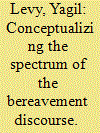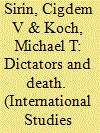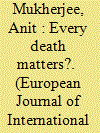|
|
|
Sort Order |
|
|
|
Items / Page
|
|
|
|
|
|
|
| Srl | Item |
| 1 |
ID:
178205


|
|
|
|
|
| Summary/Abstract |
What are the consequences of women dying in combat? We study how women fighting on the frontlines of the military affects public attitudes toward (1) military conflict and (2) women’s equality. We demonstrate through a series of survey experiments that women dying in combat does not reduce public support for war. However, women’s combat deaths do shape perceptions of women’s equality. Women dying in combat increases support for gender equality, particularly in the public sphere of work and politics, but only among women respondents. The findings indicate that women’s combat deaths do not undermine leaders’ ability to garner support for war, but combat service—and indeed, combat sacrifice—alone is insufficient to yield women’s “first-class citizenship” among the general US public. The results highlight how major policy changes challenging traditional conceptions of gender and war can generate positive attitudinal shifts concentrated among members of the underrepresented community.
|
|
|
|
|
|
|
|
|
|
|
|
|
|
|
|
| 2 |
ID:
157490


|
|
|
|
|
| Summary/Abstract |
This article presents the spectrum of the bereavement discourse, namely, how various social groups interpret the loss of their children’s lives or the potential risk to their lives posed by their military service and translate it into public discourse, as a spectrum of attitudes. It is argued that this spectrum ranges from subversive to submissive approaches. Furthermore, within the confines of the declining casualty tolerance, two variables cumulatively determine the actors’ choice of discourse: the level of enforcement of recruitment, ranging from conscription to voluntary recruitment, and the social position of the group to which the agents belong. Given that conscription brings powerful, high-status groups into the ranks who may be unwilling to make sacrifices for war, subversive responses are more likely to occur in conscript militaries than in volunteer forces and vice versa. This article maps this spectrum and hypothesizes about its determinants.
|
|
|
|
|
|
|
|
|
|
|
|
|
|
|
|
| 3 |
ID:
146161


|
|
|
|
|
| Summary/Abstract |
Why are some authoritarian regimes so quick to surrender amid lower numbers of casualties while others prove willing to incur significant casualty counts to continue their war efforts? In this study, we explore the propensity of different authoritarian regime types to sustain casualties in interstate conflicts. We argue that authoritarian leaders with smaller winning coalitions find it easier to distribute the costs of militarized conflicts outside of those coalitions. This diminishes their sensitivity to casualties. Applying a theoretical model based on an inverse divide-the-dollar game (with respect to the distribution of public “bads”), we find that personalist regimes tend to sustain the highest number of casualties in militarized interstate disputes when compared to other autocracies. Our findings suggest that along with the audience cost abilities of an autocratic adversary, target states should also consider an autocratic regime's casualty sensitivity in deciding whether to reciprocate with military action.
|
|
|
|
|
|
|
|
|
|
|
|
|
|
|
|
| 4 |
ID:
091602


|
|
|
|
|
| Publication |
2009.
|
| Summary/Abstract |
This article builds on past framing research to probe the impact of casualty frames on the public's willingness to expend additional "blood and treasure" in an ongoing war. The rhetoric of "sunk costs" (often described as "sacrifices") that must be redeemed through further conflict is a well-known, yet irrational, trope. Utilizing an experiment embedded in a nationally representative survey on attitudes about Iraq, we find that "investment frames" increase support for the war among individuals who believe the U.S. "did the right thing in Iraq," but decrease support for the war among those who feel the U.S. "should have stayed out." We also find, however, that framing effects are inconsistent when the frames are attributed to sources. These latter results demonstrate the importance of including unattributed frames to evaluate source effects in framing research.
|
|
|
|
|
|
|
|
|
|
|
|
|
|
|
|
| 5 |
ID:
183896


|
|
|
|
|
| Summary/Abstract |
How do combat missions, defined as an armed confrontation that causes casualties, shape civil-military relations and military’s role conception? This article argues that militaries that incur combat casualties gain a stronger hand in the civil-military equilibrium. This is because casualties affect domestic political opinion and give prominence to the views expressed by military officials. Civilians are then more deferential to professional military advice. In turn, the military obtains considerable operational freedom, and can pick and choose missions which they find desirable. Second, the military’s role conception – an important determinant of military missions, is shaped most prominently by its combat experience. Militaries sustaining casualties obtain leverage vis-à-vis civilians and based on their institutional preference, they either prioritise or avoid non-traditional missions. While making these arguments, this article examines combat casualties, role conception, and civilian control in India. These concepts as a whole and, the Indian case study especially are surprisingly understudied considering it is among the few non-Western democracies with firm civilian control, a record of overseas intervention operations and a military with varying roles and missions. Analysing India’s experience therefore adds to the literature and illuminates the mechanism through which casualties affect civil-military relations.
|
|
|
|
|
|
|
|
|
|
|
|
|
|
|
|
|
|
|
|
|